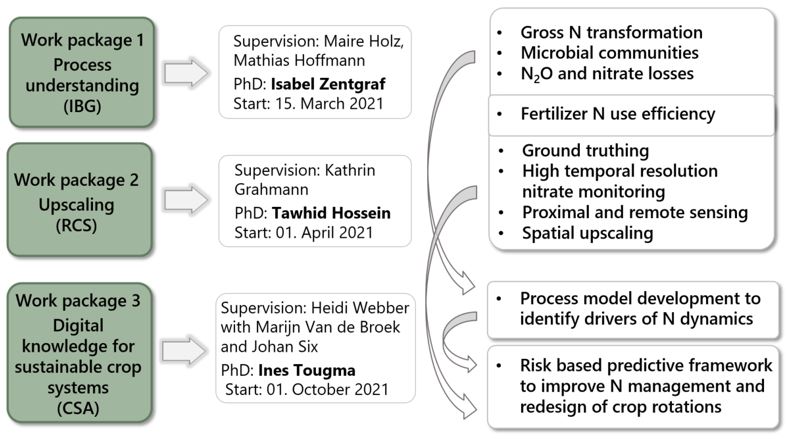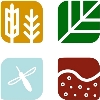IPP-Optimal N
 Bodenprobenanalyse verschiedener Stickstofffraktionen in Boden und Pflanze, © Jarno Müller/ZALF
Bodenprobenanalyse verschiedener Stickstofffraktionen in Boden und Pflanze, © Jarno Müller/ZALF ZALF finanziertes Schwerpunktprojekt mit dem Titel:
Optimale Stickstoffversorgung für Agrarlandschaften der Zukunft: digitale Technologien zur Optimierung von trade-offs.
Verantwortliche Wissenschaftlerinnen:
- Maire Holz
- Mathias Hoffmann
- Heidi Webber
- Kathrin Grahmann
Zeitraum: 2021-2024.
Fokus ist die Quantifizierung von Stickstoff Dynamiken- und Verlusten in diversifizierten Anbausystemen auf Parzellen-, Feld- und Landschaftsebene. So sollen unter anderem Beziehungen zwischen Punktfeldmessungen mit Umweltüberwachungsinstrumenten und Technologien der Nah- und Fernerkundung hergestellt werden, um die Dynamik der neuen kleingeteilten Anbausysteme in Bezug auf Stickstoffnutzungseffizienz, Auswaschungs- und gasförmige N-Verluste zu quantifizieren.
In diesem Projekt arbeiten und forschen die
Doktoranden
- Isabel Zentgraf
- Tawhid Hossain
- Ines Astrid Tougma

Arbeitspakete, Projektmitarbeiter und Aufgabenbeschreibung im Integrated Priority Project: Optimal Nitrogen, © Maire Holz
Update zu laufenden Projektaktivitäten
The Optimal N project combines the expertise of 3 working groups at ZALF, combining three work packages (WP1-3) to derive a holistic understanding of the N transformation processes with the aim of informing improved cropping system design and management. The work includes experimentation using 15N isotopes to trace the fate of N within a cropping season, proximally and remotely sensed data improve the understanding of drivers of spatial heterogeneity and development and application of an integrated crop-soil model to assess options for more efficient N management.
WP-1
Objective of WP1
This work package builds on a holistic process understanding of N transformations. The aim is to quantify small-scale variability of N-transformations and –loss processes within agricultural landscapes and understand their driving factors. This will be done by combining 15N tracer techniques, N2O emission measurements and specific on-site plant and soil analyses.
Field activities
Biomass, root and soil sampling until 90 cm depth as well as N2O emission measurements are conducted from 2021-2024; 15N tracer techniques are carried out until mid of 2023. Six patches with different soils values and crops are covered.
Image fieldwork
 Experimental set-up of micro-plots and N2O emission measurements in rapeseed patch, © Isabel Zentgraf
Experimental set-up of micro-plots and N2O emission measurements in rapeseed patch, © Isabel Zentgraf
Dissemination of ideas and results
Year 2022
WP-2
Objective of WP2
The core objective of WP2 is the application of digital tools, specifically proximal and remote sensing, for better understanding and monitoring of N dynamics in newly designed field arrangements of patchCROP.
Field activities
Extensive spatio-temporal soil and biomass sampling has been conducted through 2021-2023 cropping season to develop methods for monitoring N dynamics across space and time. We have covered 7 crops (rye, barley, wheat, oat, rapeseed, sunflower, maize) in six patches. Furthermore, STENON proximal sensor as well as Satellite and UAV imagery are integrated with field data to develop methods to monitor spatiotemporal N dynamic in a heterogeneous cropping system.
Image fieldwork
 Bulk density campaign in March 2022, © Tawhid Hossain
Bulk density campaign in March 2022, © Tawhid Hossain
Dissemination of ideas and results
WP-3
Objective of WP3
WP3 aims to include nitrogen transformations in a state-of-the-art soil organic carbon model coupled with a cropping system model to assess crop management strategies at the field scale that maximize crop yield while minimizing nitrogen losses, accounting for soil heterogeneities and uncertain weather conditions.
Field activities
The integrated soil-crop model will be parametrized and validated with data collected in WP1 and WP2 as well as data on crop development stages and microbes C and N contents, collected in the patchCROP experimental site.
Dissemination of ideas and results

